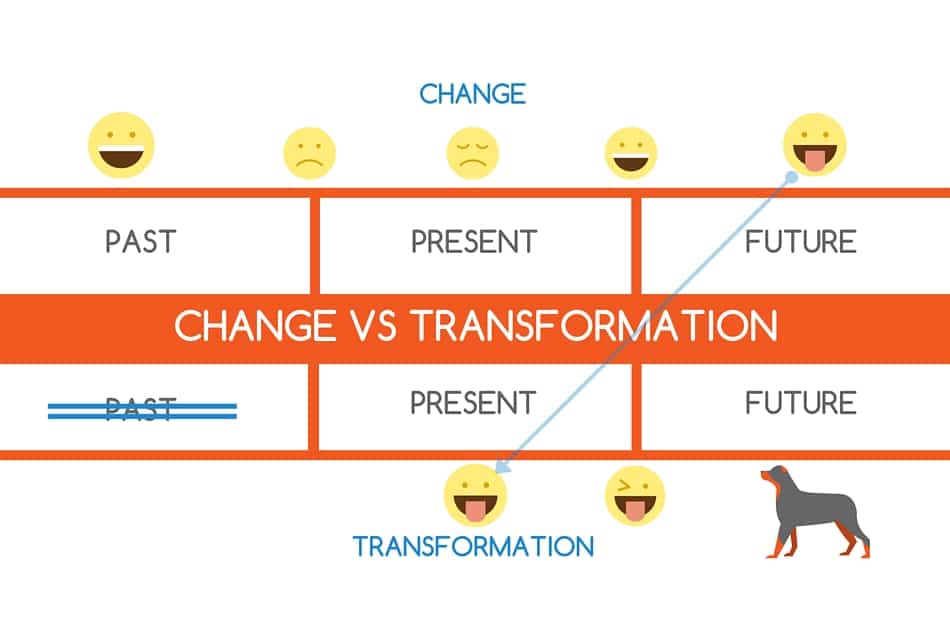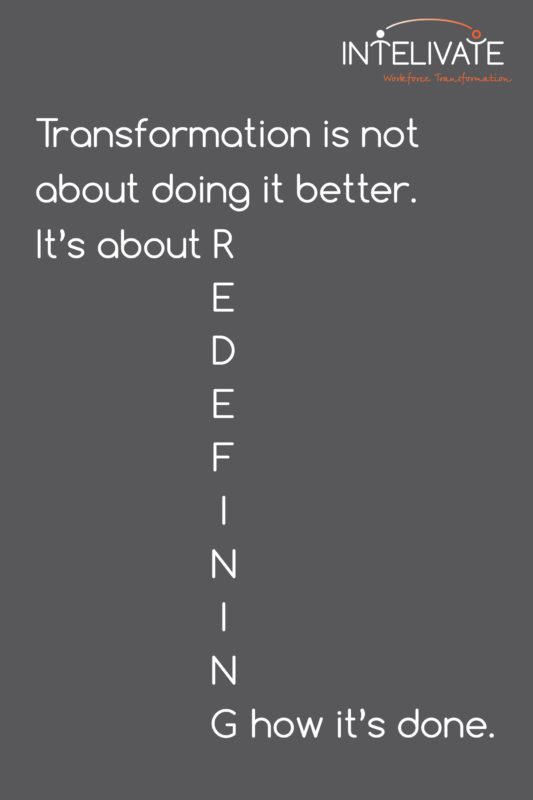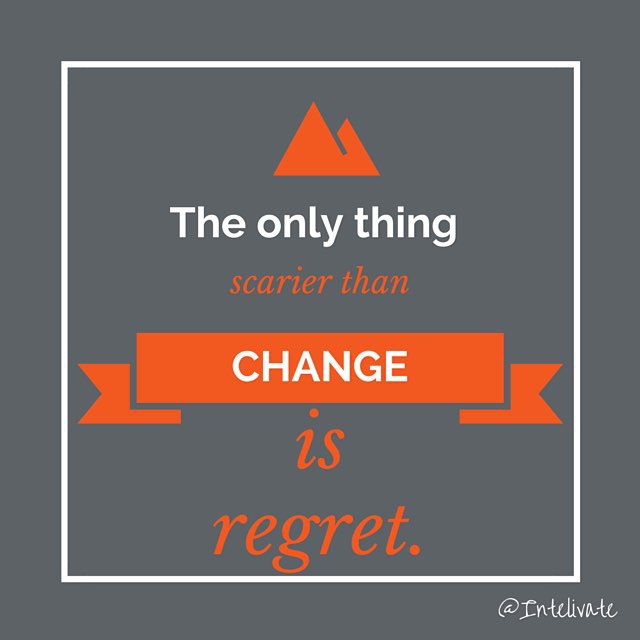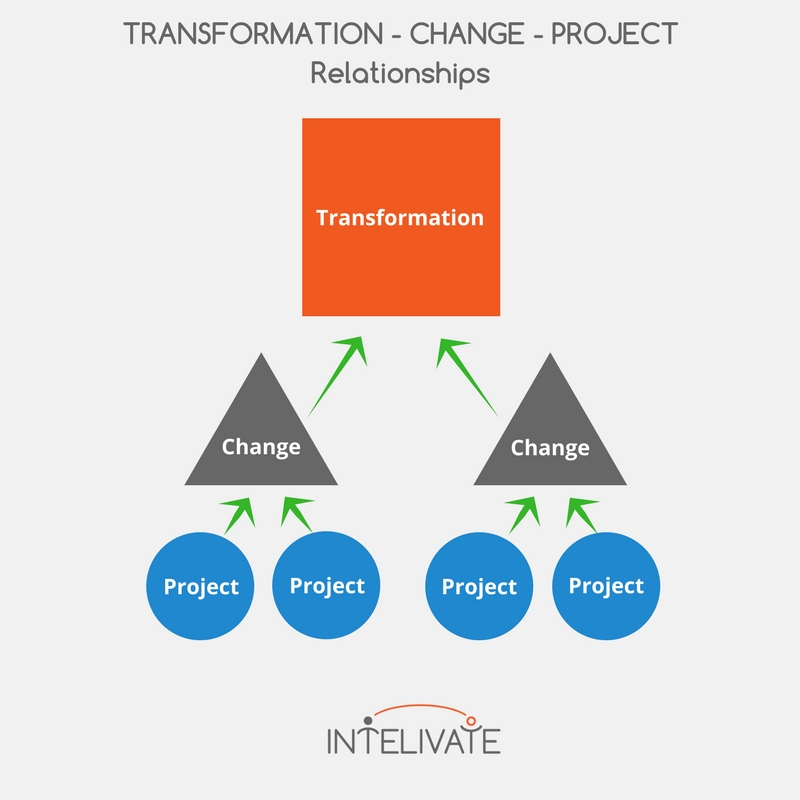Understanding these six critical differences of organizational change and transformation saves you a ton of budget, frustration, and heartache.
It’s not transformation unless you become a dog.
Recently, I spent a day collaborating with a group of executives for a Fortune 500 planning a ‘transformation.’ I received piles of projects with impressive displays of “TRANSFORMATION” anywhere they could fit the word.
As I started skimming the plans, I became increasingly confused asked,
“What are your goals in this?”
As they explained in full details, I started marking the number of times they said the word transformation. I ran out of room on the remaining tablet screen space. I told the executives I needed more time to do a thorough review and to make detailed recommendations.
The one I could make immediately is to take the word transformation out of all of their plans.
Crickets.
That is all I heard while I looked at their confused faces through a video conference lense. Initially, I thought the video and audio had frozen.The video conferencing was operating just fine – what had frozen was their expressions.
I told them based on plans and goals that these plans were for change – not transformation.
They looked even more confused and only moved to look at each other. I explained it in every way I knew how – the differences, the relationship of the two, the connection of the two and used life and work examples.
Finally, I asked for 15 minutes and developed the very rough ‘infographic’ displayed above (thank you, Canva!). When they returned, I beamed the visual to all of their tablets, asked them to examine it for 5 minutes and take notes.
I told them that if they are not looking to become a dog relative to the other icons here, then you are not looking for a transformation. They want change.

They got it. Somehow and in some way the visual did it. The dog is what it took to get the message through.
I explained that they would save much money and experience much more project success by focusing on their real goal of change as opposed to transformation. The planning of budgets and execution of both are very different.
What is Organizational Change?
Organizational change is assessing the past, comparing it to the present and determining the ideal future state from the current business state. Success measurement of change is how much better the future state is from the current state.
What is Business Transformation?
Transformation is redefining what something is (the current state). It begins by first assessing the present to the desired future. Success measurement of business transformation is how much different the future state is from the current state based on the initial vision and organizational strategy definition.

Business Transformation is More than a Trending Buzzword
Throughout the 90s and into the first decade of the millennium, change management was the buzzword throughout corporate. It sometimes just plain got out of control. It seemed like changing a toilet paper roll required a change management plan from the organizational change management office.
I am witnessing a similar but more destructive pattern as it relates to ‘transformation.’ Every organization is using the newly-crowned buzzword, but few I have seen execute business transformation.
They are still very much focused and planning around change management but are now just calling it transformation. That is costly for many areas including budgeting, success measures and rates and overall culture and morale with the latter taking the biggest tolls.
The number one reason business transformation programs fail because most organizations and people do not fully understand what transformation is.
Business transformation is very different from change management. Each has a very defined role in organizational goals.
6. Goals and Process Differences Between Organizational Change and Transformation
The goals and processes of business transformation and change are entirely different. Additionally, you’ll soon learn that the dependencies on both are also different, which is key in defining specific goals for each.
Goal of organizational change
The need to change is identified by a standardized assessment of the present to the past.
Think about that for just a minute.
When you have decided to make a change, you are evaluating current state to the past. That process goes back and forth until there is a determination that something must change. The process continues even through all stages of change management. There is a constant evaluation of past and present to gauge progress and to measure completion and success.
From an organizational perspective, that measure of success is ROI.
Did the totality of the change management investment indirectly or directly drive revenue?
For an individual, change project success is still ROI but likely more intangible albeit should still be measurable.
One of the causes of failed change initiatives is the lack of business process documentation. Making major decisions based on assumptions sets you up for failure.
The result of change
You (organization, leader, team or individual) – only better – based on your defined change objectives. The result of change might even be you becoming what you were in the past because you broke something along the way.
It all depends on the goals of the defined change, but ultimately you are still ‘you’ but in a different state.
Goal of business transformation
Transformation assesses the present with little or no regard to the past to define an entirely different future.
The goal of different does not mean forgetting critical lessons of the past during the transformation process. You have learned through a series of changes, and you must bring those experiences forward – including to forgive but never forget the past.
Throughout the transformation process, there is a constant assessment of present and future with intermediate milestones to gauge progress and success.
The result of business transformation
The result of the transformation is something or someone that is completely different from the present. You (organization, leader, team or individual) became something entirely different and redefined based on your assessment of the future and your objectives of redefining the future.
What you do and how you do it is entirely different from today.
Based on the diagram above, your business transformation led you from a person to a dog.
Is a dog better than a person (well, there is much debate around that sometimes with dog lovers)? It does not matter. The comparison of whether the future is ‘better’ than the present is an organizational change comparison.
The comparison of whether the future is entirely different from the present is a transformation comparison.

5. Origination Differences of Organizational Change & Business Transformation
Transformation and organizational change must start from different levels of the business.
Origination of business transformation
Business transformation originates at the highest level of an organization due to its goals, magnitude, and scopes of timing and budget.
Transformation cannot originate in a department, division or team. Organizational strategy, process, and training will not support that transformation sustainably. If you are transforming a department, you are completely redefining the division and likely misaligning it out of the current operating structure.
The exceptions to this are for large divisions and departments that receive direct support from the highest level of the organization. The root support for the business transformation is still originating from the top.
Origination of organizational change
Change can originate in any part of the organization. The key to success is to ensure alignment with the overall business strategy. Always confirm that there are no other change initiatives that will overlap or contradict the change you are planning.
What I am about to say will cause more than one senior executive to read this next statement five or ten times:
Organizational change SHOULD NOT originate at the highest level of an organization.
It is a waste of resources and a lack of leverage of senior leadership and thought leaders. However, organizational change still requires the support from the highest levels of business leadership.

4. Current Business State Differences of Change and Transformation
Current state of organizational change
As we determined, change is about ‘opportunity’ or fixing something in the present relative to the past and changing that for the future. Inherent to that, the current state is less than ideal.
That is what prompts the need for organizational change and is the ultimate mark of success – are you better in the future than you are today?
Current state of business transformation
To even begin to think about transformation, you (an organization, leader, team or individual) has already got to be in a stable ‘happy’ place especially from an organizational perspective. You cannot successfully transform unless you have a healthy level of stability.
The current state status is marked in the diagram above and also illustrates the next major difference which is the relationship dependency.
3. Dependency Differences of Change and Transformation
In the grand hierarchy of the relationship, a series of organizational change initiatives build up to the official launch of a business transformation initiative.

The multiple change initiatives correct the current state to a level of stability to define, plan and execute transformation. Transformation is ultimately dependent on incremental change. Organizational change has absolutely no dependency on transformation.
2. The Depth of Organizational Strategy Differences of Change and Transformation
One of my favorite parts of an Intelivate initiative is the leadership strategy definition phase. It is a powerful process for leaders or groups of executives to determine their future state.
During this stage of strategy development, we discover if the organization is desiring and should be planning for transformation or change. Once we determine business transformation vs. change, the vision definition is very different for both.
Organizational change strategy definition
The strategy definition around change is tangible, immediately measurable, discreet (a very defined beginning and end) and immediately tactical.
There is a precise definition of the targeted program in a change management plan and exactly how the focus of change will operate in the future state.
Transformation strategy definition
The strategy definition around business transformation is much more intangible, deeper and must remain more fluid at the beginning. Rigidity in the transformation plan is the biggest mistake organizations make during project execution.
There are many unknowns with a business transformation that can be defined and mitigated at a high-level early on but need to remain fluid as parts of the transformation become operational.
That is the hardest part of a group of executive leaders to grasp, and it is understandably so as they are accustomed to the rigidity and tight definitions of change management programs – especially as it relates to planning which brings us to the fifth critical difference of transformation and change.
1. Planning and Project Execution Differences of Change and Transformation
Inherent to the definitions and differences of transformation and change, the planning and implementation must be done differently to achieve project success. This is particularly important in the project organization.
Organizational change timeline & budget
Change is determined and executed when there is an opportunity identified – a need, expectation, desire or performance target not achieved. The timing of change depends on a less-than-ideal present state as compared to the desired end state.
The timeline of change, if the change opportunity is defined correctly and is not a symptom of the core issue, is very discreet. There are definitive beginnings and ends to the organizational change initiative.
These defined start and end points are necessary because one change initiative launch is almost always dependent on a milestone or end of a separate change action. Many times these related and dependent change initiatives are building to a business transformation launch.
Business transformation timeline & budget
Transformation is officially defined once an organization gets to a stable present-state.
That is not to say that the initial vision cannot be developed much earlier with the recognized need for a series of change initiatives to be defined and launched before an official transformation definition.
Once in a stable state and an official transformation start, the timeline must remain relatively fluid, and expectations set accordingly amongst all layers of the organization that are initially involved.
This is why incremental phases are critical in a transformation plan.
Progressive planning
Because of the initial ‘unknowns’ of transformation, it is imperative to design incrementally so that timelines can be defined more discreetly during the transformation.
Depending on the scope and initial estimates of the business transformation, break the increments into 1/4 of the overall plan at most.
Initially and mainly to calm shareholder’s nerves, you should potentially design the first 1/4 and further break that up into very discreet increments with milestones, measures, and timeline updates.
Strategic Talent Resourcing
Because of the nature and origination of transformation, critical talent must be identified and retained throughout the course of the transformation.
If this talent is not recruited and secured, there will be vast disconnects in vision, execution and ultimately the result. Many times the transformation will not complete without these resources.
Strategic staffing and retainment are critical to any business transformation success. That does not mean there should not be talent and role transition throughout the transformation. That is where incremental planning comes into play and talent should be resourced accordingly. However, there must always be a constant in the comprehensive critical talent resources for any transformation to be successful.
The nature and duration of change allow more fluidity of talent throughout the process; however, key talent should be identified throughout and, at least, one constant champion of the initiative should be strategically resourced and retained until the completion of the change effort.
Depending on the scope of the change effort, this may require multiple talent champions.
Final Thoughts
There you have them – the most critical differences between business transformation and change.
Let me emphasize that both transformation and change are essential for the overall health, success, and sustainability of any organization.
They play different roles and hopefully, you have a better understanding of the what, why, how and who’s to successfully implement both change and transformation into your overall project success planning!
Keep Reading: Effective Collaboration By Streamlining Your Internal Communication Tools →
Related Organizational Change and Transformation Solutions
> B2B Consulting and Organizational Strategy Solutions
Kris Fannin
Kris Fannin is a passionate change agent in workforce transformation. For more than 25 years, he's had the privilege of partnering with dozens of client organizations and leading hundreds of teams to become powerful influencers.
"Your legacy will be defined by the passion and impact of the people you influence. What do you want your legacy to be?"




